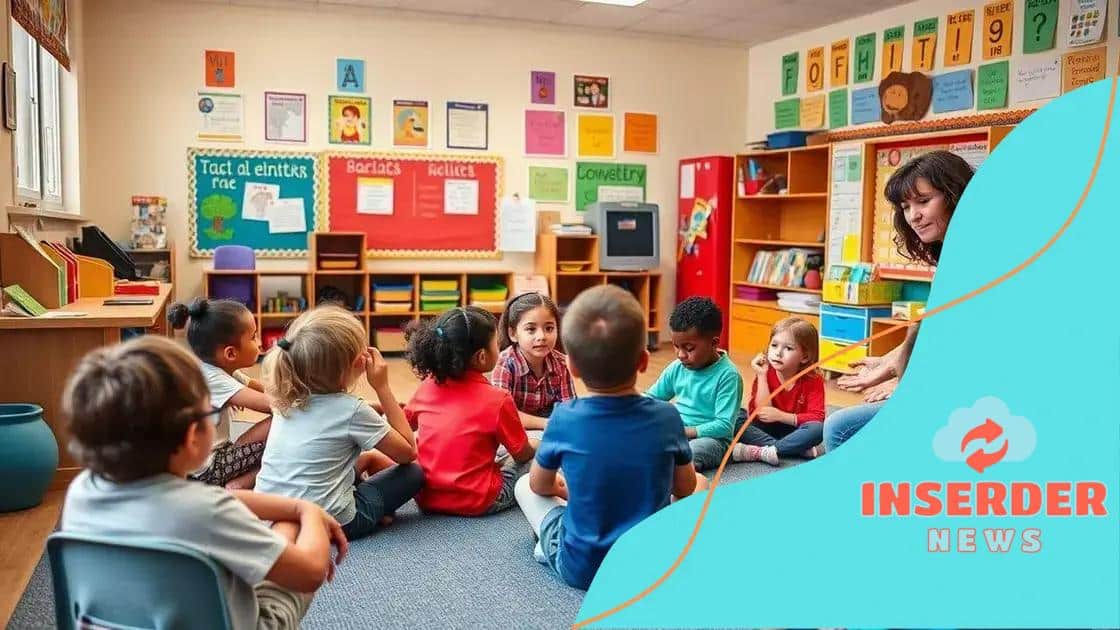Integrating social-emotional learning into school systems

Integrating social-emotional learning into school systems enhances students’ emotional intelligence, improves academic performance, and fosters healthier relationships, equipping them with essential skills for future success.
Integrating social-emotional learning into school systems is becoming increasingly crucial in today’s educational landscape. Have you noticed how schools are evolving to better support students’ emotional well-being? This article delves into how these practices can transform learning environments.
Understanding the importance of social-emotional learning
Understanding the importance of social-emotional learning (SEL) is essential for creating supportive school environments. SEL equips students with vital skills for managing emotions and fostering positive relationships.
Why SEL Matters
Research shows that incorporating SEL into education can improve students’ academic performance and emotional well-being. When students learn to understand their feelings, they become more engaged in the classroom.
A strong foundation in SEL helps students:
- Build resilience against challenges.
- Enhance their problem-solving skills.
- Improve their communication abilities.
Furthermore, SEL can create a classroom atmosphere where students feel safe and valued. This emotional safety encourages them to express themselves and engage with their peers.
The Impact of SEL on Academic Success
Students who participate in SEL programs often show higher grades and better attendance rates. These programs teach skills that contribute to positive behaviors, both academically and socially.
Not only does SEL promote personal growth, but it also cultivates empathy and understanding among students. Encouraging students to put themselves in others’ shoes can create a more inclusive environment.
Incorporating social-emotional learning into daily routines can be as simple as implementing group discussions, role-playing, or mindfulness exercises. These activities not only create an engaging classroom but also reinforce the importance of emotional intelligence.
SEL also positively impacts teachers. When educators model emotional awareness, they set an example for students, creating a culture of respect and communication.
Conclusion
By prioritizing social-emotional learning, schools can cultivate a nurturing environment that supports every student’s growth and success. A focus on SEL fosters an educational experience that prepares students for the complexities of life beyond the classroom.
Key components of social-emotional learning frameworks
The key components of social-emotional learning (SEL) frameworks provide a structure for teaching students essential life skills. Understanding these components helps educators implement effective programs.
Core Competencies of SEL
The Collaborative for Academic, Social, and Emotional Learning (CASEL) outlines five core competencies crucial for SEL:
- Self-awareness: Recognizing one’s emotions and thoughts.
- Self-management: Managing emotions and behaviors in different situations.
- Social awareness: Understanding social norms and responding to others appropriately.
- Relationship skills: Building healthy relationships through communication and cooperation.
- Responsible decision-making: Making ethical, constructive choices about personal and social behavior.
These competencies serve as the foundation for effective SEL initiatives in schools. When students develop these skills, they are better equipped for challenges both in and out of the classroom.
Integrating SEL into Curriculum
Integrating SEL into existing curricula is vital for its effectiveness. Educators can weave SEL into various subjects by using real-life scenarios and discussions. For example, teachers can incorporate emotional intelligence discussions into literature or history lessons.
Maintaining a focus on social-emotional learning can enhance students’ engagement. Activities like role-playing and group projects promote collaboration and empathy among peers. This approach encourages students to practice their SEL skills in a safe and supportive environment.
Additionally, creating an inclusive classroom culture fosters SEL development. When students feel valued and accepted, they are more likely to participate actively in their learning. Educators play a critical role in modeling respectful behavior, reinforcing positive interactions and communication.
Measure and Adapt SEL Frameworks
Evaluating the effectiveness of SEL frameworks is important. Schools should collect feedback from students, teachers, and parents to identify areas for improvement. Regular assessments help tailor programs to meet the unique needs of each student.
By prioritizing the key components of social-emotional learning, schools can enhance students’ overall experience and well-being, leading to a more supportive and engaged learning environment.
Strategies for implementing social-emotional learning

Implementing social-emotional learning (SEL) in schools can transform the educational experience for students. By adopting effective strategies, educators can create a supportive environment that fosters emotional intelligence.
Creating a Safe Space
One of the first steps in implementing SEL is to create a safe and inclusive classroom environment. Students should feel comfortable sharing their thoughts and emotions. Teachers can establish ground rules that promote respect and confidentiality, ensuring that all voices are heard.
Encouraging open discussions about feelings can help students connect with one another. When they see their peers expressing emotions, they are more likely to share their own experiences.
Incorporating SEL into Daily Activities
Integrating social-emotional learning into daily classroom activities enhances its effectiveness. Teachers can weave SEL skills into lessons through group projects and collaborative tasks. This not only builds teamwork but also helps students practice empathy and communication.
Utilizing literature and storytelling is another effective strategy. By discussing characters’ emotions and decisions, students can relate these stories to their own lives. This helps them develop critical social-emotional skills.
- Role-playing: Engage students with role-playing scenarios that depict real-life situations.
- Mindfulness practices: Introduce mindfulness activities to promote self-awareness and emotional regulation.
- Reflection exercises: Encourage students to reflect on their daily experiences and feelings.
Another key strategy is to involve families in the SEL process. Parents can reinforce SEL concepts at home, fostering consistency between school and family environments. Providing workshops for parents can help them understand the importance of SEL.
Training Educators
Teachers play a crucial role in the success of SEL implementation. Providing professional development focused on SEL allows educators to understand its significance and to teach these skills effectively. Training can offer practical tools and strategies to incorporate SEL into their teaching practices.
Moreover, ongoing support from school administrators is essential. Regular feedback and resources can help teachers feel confident in applying SEL principles in their classrooms.
By carefully planning and implementing these strategies, schools can significantly enhance the development of social-emotional learning among students, leading to increased emotional well-being and academic success.
Benefits of social-emotional learning for students
The benefits of social-emotional learning (SEL) for students are profound and long-lasting. By developing essential emotional and social skills, students can improve their overall well-being and their academic performance.
Improved Academic Performance
Research indicates that when students engage in SEL programs, they often experience improved academic results. SEL helps students develop focus and motivation, which are critical for success in school. As they learn to manage stress and emotions, their capacity to concentrate on learning increases.
Additionally, SEL teaches students to set goals and problem-solve effectively. This skillset allows them to navigate challenges more successfully, whether academic or personal.
- Enhanced emotional regulation: Students learn to understand and manage their emotions, leading to better classroom behavior.
- Increased engagement: With improved emotional support, students participate more actively in class.
- Stronger relationships: SEL fosters positive relationships among peers and teachers, promoting a supportive learning environment.
As students develop these skills, they often show greater resilience. They learn to bounce back from setbacks and seek help when needed, which is essential for navigating the complexities of school life.
Social Skill Development
Another significant benefit of SEL is the enhancement of social skills. Students who participate in SEL programs learn how to communicate more effectively and work collaboratively with their peers. These skills are crucial not only in school but also in their future careers.
By navigating group dynamics in classroom settings, students practice empathy and conflict resolution. They learn to appreciate diverse perspectives, building a sense of community within the classroom.
Engaging in team-building exercises or collaborative projects reinforces these social skills. As they engage with others, they refine their ability to listen, share, and support one another.
Long-term Benefits
The positive effects of social-emotional learning extend beyond the classroom. Studies show that students with strong SEL skills are more likely to succeed in life. They often have lower rates of behavioral issues and are at a reduced risk for cognitive difficulties.
Being emotionally intelligent helps students develop healthy relationships and make responsible choices. These abilities contribute to their overall mental health, leading to happier and more fulfilling lives.
In sum, by incorporating SEL into education, schools can equip students with vital skills that promote success both during their academic journeys and throughout their lives.
Measuring the impact of social-emotional learning programs
Measuring the impact of social-emotional learning (SEL) programs is vital for understanding their effectiveness and making necessary improvements. Schools and educators must assess how well these programs are helping students develop crucial skills.
Using Assessment Tools
Several tools can help evaluate SEL impact. Surveys and questionnaires are common methods that gather feedback from students, teachers, and parents. These assessments can measure students’ emotional growth, relationship skills, and overall well-being.
Standardized assessments can also be used to track changes in academic performance, attendance, and behavior. Schools can compare data from before and after implementing SEL programs to see tangible effects.
- Behavioral assessments: Observations of student interactions in the classroom can provide insights into social skills development.
- Self-assessment tools: Allowing students to rate their own emotional and social skills encourages self-reflection.
- Focus groups: Gathering small groups of students for discussions can reveal deeper feelings and experiences related to SEL.
Combining quantitative data with qualitative insights provides a comprehensive view of SEL program effectiveness.
Tracking Long-term Outcomes
It’s essential to monitor long-term outcomes to understand the lasting effects of SEL programs. Schools can follow students into higher grade levels to see if their emotional and social skills continue to develop. Tracking these outcomes can highlight the importance of SEL in overall student success.
Moreover, analyzing data on students’ mental health, relationships, and problem-solving abilities helps assess long-term benefits. This tracking can show whether SEL programs have a lasting positive impact on students’ lives.
Engaging families in the assessment process can strengthen the support system for students. Parents can provide feedback on their children’s social and emotional development at home, which reinforces the skills learned at school.
Adapting Programs Based on Data
Once the impact has been measured, schools can adapt their SEL programs accordingly. Data-driven decisions enable educators to improve the curriculum based on what is working and what isn’t. This can involve enhancing certain activities, introducing new ones, or adjusting the teaching methods used.
Regular evaluation ensures that SEL programs remain effective and relevant to students’ needs. By measuring impact, schools empower themselves to provide the best possible support for students, fostering an environment where emotional skills can thrive.
In summary, integrating social-emotional learning (SEL) into educational systems offers numerous benefits that extend far beyond the classroom. By focusing on SEL, schools can enhance students’ academic performance, improve their emotional health, and equip them with essential life skills. Engaging students in activities that promote self-awareness, empathy, and responsible decision-making lays the groundwork for their future success.
Regularly measuring the impact of these programs is vital. It allows educators to fine-tune their approaches, ensuring that they meet the evolving needs of students. With strong support from teachers, families, and administrators, the implementation of SEL programs can build a more compassionate and effective school environment, preparing students for the challenges they will face in life.
FAQ – Frequently Asked Questions about Social-Emotional Learning (SEL)
What is social-emotional learning (SEL)?
SEL is a process that helps students develop skills in managing emotions, setting goals, showing empathy, and maintaining relationships.
How does SEL benefit students academically?
Students who participate in SEL programs often see improved grades, better attendance, and increased classroom engagement.
What methods are used to assess the impact of SEL programs?
Assessment methods include surveys, self-assessments, behavioral observations, and analyzing academic performance data.
Can SEL programs help students in their future careers?
Yes, SEL skills like teamwork, communication, and emotional regulation are essential for success in the workplace and personal relationships.






